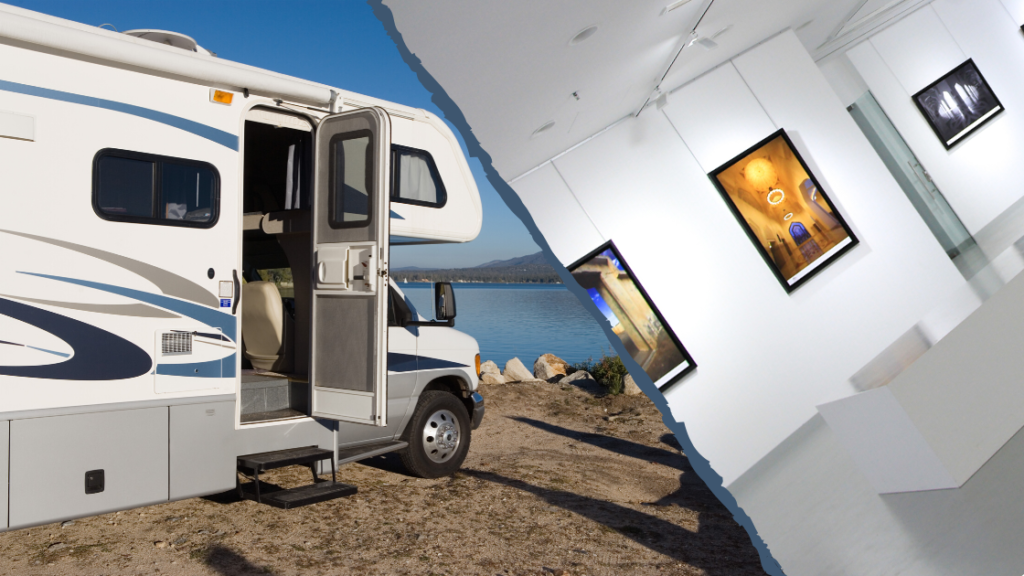We’ve previously discussed the value of museums. They are, ideally, institutions of society, keepers of history and culture, educators of the public, and connectors of people across communities. One of the limitations of museums is that they require people to come to them. They’re dependent on curious, interested people who are willing to take time out of their day and, in many cases, pay money to see their collection. Museums everywhere grapple with the problem of how to get people through the doors. One solution is to bring the museum to the people through mobile museums.
Pieces of art move around all the time. They are acquired or loaned by institutions or individuals. They move in and out of private collections and public museums. Exhibits travel around the world to the different museums that have contributed the resources to make them happen. A mobile museum is a different from moving pieces of art or traveling exhibits. It bridges the gaps between communities, allowing the value of museums to be disseminated across a wide area so that there are no obstacles for people hoping to see its collection.
Past Examples of Mobile Museums
In 1963, to celebrate the Tercentenary of North Carolina, a mobile museum showcased historical artifacts from the state’s beginning 1. The people who organized it knew that the state’s history was so vitally important that they couldn’t leave it in one place and tell people to travel to see it.
In 1931, Yuri Samarin implored loyal Soviet museum directors to create mobile museums to “englighten” Russians about the wonders of the relatively new Soviet State 2. In this case, a mobile museum was used to share the vision of a State, and you may disagree with the message, but there is no denying the potential power in transporting exhibits to different communities in an effort to educate and elevate.
Current Examples
There are several current examples of successful mobile museums as well. Most of these travel to schools and offer science programs to children. These programs are immersive and interactive, providing hands-on education for school age kids.
There are also art mobile museums. Again, the primary audience is children. These museums drive around to different schools and offer educational programming. Go Van Gogh is a mobile art museum that teaches Dallas school children about the Dallas Museum of Art collection while also encouraging art creation 3. Similarly, the New Mexico Department of Cultural Affairs has its Wonder on Wheels, which takes items from one of its eight museums to fourth and fifth graders across the state of New Mexico 4. In this way, the mobile museum replaces the classic school field trip to the museum. These visits fulfill the requirement for art education outside the school curriculum.

While the mobile museum is great for kids, there are also a number of mobile museums that are created for an older audience. One, in Virginia, has had a rebirth after about 30 years. Started in 1953, the Virginia Museum of Fine Arts ArtMobile traveled around the state to different galleries, museums, and libraries. The Museum shifted their strategies in the 90s and the ArtMobile program ended. This year, the mobile museum is back. The current quarantine has disrupted its schedule, but it looks poised to make a full comeback 5.

Future of Museums?
As we can see, the mobile museum is not a new concept. From 1930s Russia, 1963 in North Carolina, to a revitalization of an older model in Virginia today, this model for sharing museums with a wider audience has been around for a long time. The opportunity to expand an audience is huge with mobile museums. As with everything else, clear messaging and vision are so important here. Otherwise it’s just art in a van or RV. Mobile museums must say something, just as their brick and mortar counterparts do. They have to make an argument. Even if you don’t agree with Samarin’s devotion to the Soviet state, he’s absolutely right that enlightenment is the goal here.
Most commonly, mobile museums are ways to get kids out of the classroom and into immersive science programs without having to deal with the logistics of coordinating a field trip. The New Mexico Department of Cultural Affairs and Go Van Gogh work in a similar way as the mobile science museums, and provide hands-on, immersive education to kids. We need more of that, especially as field trip days decrease.
The mission of this site is to connect people to art. There is a great opportunity to use mobile museums to achieve that, which is very exciting. What sort of art would you like to see come into your town? Would you want to see the collections of museums that are hard to get to? Or would you want to highlight the artists in your own community? These are the questions that we need to ask, and it’s an exciting avenue to take.
- “Mobile Museum, Publications, Activities Mark Tercentenary in North Carolina,” History News 18, no. 8 (1963): 113–113.
- Yuri Samarin, “The Experience of Developing Mobile Exhibitions,” 17.
- “Go van Gogh® | Dallas Museum of Art,” https://dma.org/schoolprograms/go-van-gogh.
- “Wonders on Wheels,” accessed May 12, 2020, http://www.newmexicoculture.org/museum-resources/wonders-on-wheels.
- EMILY JENNINGS AND CLINT SCHEMMER Culpeper Star-Exponent, “Museum-on-Wheels to Bring Virginia Masterpieces to Culpeper Area,” Culpeper Star-Exponent, https://www.starexponent.com/entertainment/museum-on-wheels-to-bring-virginia-masterpieces-to-culpeper-area/article_87775953-1fc9-510e-8678-9333c7dbaae6.html.

